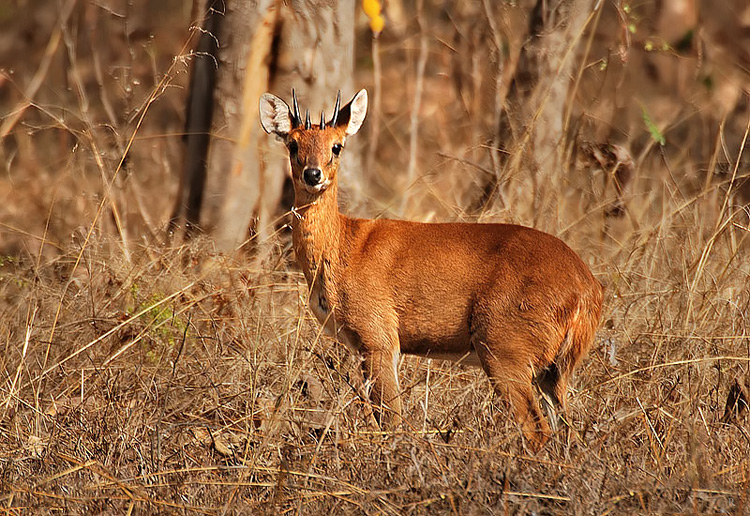Endemic to the Indian sub-continent, the four-horned antelope (FHA) or Chousingha is listed as Vulnerable (C2a (i)) in the IUCN Red list. In 2008, there were an estimated 10,000 adults in the wild in Nepal and India. Being a low-density species, FHA are particularly sensitive to changing habitat conditions and anthropogenic pressures. In India, the species is protected under Schedule-I of the Wildlife Protection Act (1972).
At present, there is little scientific information available on the four-horned antelope, and the habitat variables that influence its occurrence. There is a critical need for ecological studies focused on the Chousingha so that conservation efforts can be effectively directed at preventing the decline of its populations.
Authors Y.C Krishna, J. Krishnaswamy and N.S Kumar identify habitat dynamics that shape the occupancy and abundance of the four-horned antelopes in the Bandipur National Park, Karnataka. These are the highlights of their study published in the Journal of Zoology in 2008.
Study area
The study was conducted in 880 sq km in Bandipur National Park, a dry deciduous forest in Karnataka, which receives an annual rainfall of 700mm to 1200mm. Bandipur supports four habitat types: dense forest, woodland to savanna woodland, tree savanna, and scrub woodland and dense thicket. There are over 156 villages located in the study area, supporting a population of 1,26,000 people and livestock population of 1,16,000. The forest also hosts large growth of the invasive plants, Lantana camara and Eupatorium.
Field sampling included recording of direct sightings and dung piles, and was conducted from January 2006 to April 2006. Observers walked and recorded both direct sightings and dung piles found within their search width. A uniform sampling effort of 1.4 km was invested. A total of 69 sample grids (each: 2 x 2 km) were surveyed covering an area of 276 sq km in Bandipur. Each grid was sub-divided into four sub-grids and each sub-grid was considered as one spatial replicate.
Methods
Four-horned antelopes mostly occur in dry deciduous forests – usually open spaces characterized by less canopy cover. A total of eight ground-based covariates were identified. The criteria to measure habitat variables included covariates that reflect habitat type, forest understorey structure, covariates that indicate past and ongoing anthropogenic disturbances and presence of invasive plants. To explore species-habitat relationships data at broad spatial scales for the entire landscape, two NDVI-based (Normalized Difference Vegetation Index) – NDVI mean and NDVI coefficient of variation covariates were derived.
Cloud-free IRS Wifs images were obtained for dates 14 December 2000, 21 January 2000 and 6 March 2002 that represent maximum changes in variations in plants and animals in wet to dry seasons.
To obtain accurate occupancy estimation, detection histories were recorded for each grid (considering detection of animal/animal sign, non-detection and missing observations).
Results
- The estimated species detection probability was between 0.44 and 0.58.
- In the 34 grids where four-horned antelopes were detected, the number of detections varied from 1 to 9. The estimated naïve occupancy of the species in 34 grids was 0.50.
- The analyses revealed that the tree-savanna deciduous habitat sub-type and open habitats with lower tree density and high degree of deciduousness was best preferred by the species.
- The covariates measured on ground – the vegetation and composition are the best predictors of occurrence of the species.
- The invasive species Lantana camara was present in 92% of the sampled grids. While assessing the negative effects of threats by invasive plant species, the model weight for lantana (0.45) is higher than Eupatorium (0.07). The study suggests that invasives can directly reduce habitat suitability for the species by changing the habitat type and structure.
Conservation implications
This is the first ever study conducted on the occurrence and abundance of the four-horned antelopes in Bandipur National Park. The estimated occupancy parameter provides a baseline estimate against which future estimates can be compared to assess changes that occur over time. Four-horned antelope prefers dry deciduous and tree-savanna deciduous forest, hence making it sensitive to large-scale changes in habitat structure and composition — more so, since these forests are prone to frequent forest fires. An appropriate management of human-induced fire and forest extractive activities is critical to its survival.


 CI is a non-profit, non-commercial portal that aims to facilitate wildlife and nature conservation by providing reliable information and the tools needed to campaign effectively.
CI is a non-profit, non-commercial portal that aims to facilitate wildlife and nature conservation by providing reliable information and the tools needed to campaign effectively.